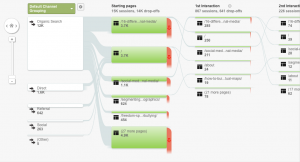Is your blog living up to its full potential? In this beginner-level how-to, columnist Joe Goers explains several ways to utilize your blog for SEO gains.

Seemingly every company has a blog these days. Unfortunately, very few organizations fully capitalize on their blog content to maximize SEO results. Here are eight simple ways a blog can improve your website’s organic visibility, traffic and results.
1. Create a compelling name for your blog
It irks me when I go to a company’s website and the name of the blog is… “Blog”! I urge marketers to be creative and more descriptive when naming the blog section of a website. Your blog name is also an optimization opportunity. Ask yourself these questions:
- What is the overarching theme of the blog?
- What would be a compelling description in my industry?
- Can I incorporate important SEO keywords in the blog’s title or name?
- Specifically, who am I trying to reach?
Coming up with a descriptive name and optimizing around a theme can lead to incremental organic traffic. For example, office supply retailer Staples has its “Staples Business Advantage blog,” which discusses topics ranging from office productivity to workplace safety. And Berghoff Brewery has its “Berghoff Beer Blog,” which covers topics from beer festivals to food pairings to seasonal beer reviews.
Remember, if you find it difficult to create a name for your blog that includes keywords you are trying to target, then try to at least include those keywords within the page title of the blog. For example, check out the page title for the RENTCafe blog:

2. Reach a specific audience with each post
I recommend that each blog post be written for a specific segment of your target audience. This allows marketers to create content that is optimized for specific customers and contains target keywords related to specific needs and solutions.
For example, if you sell marketing services, you might include a post in your blog about a hot topic in the industry (e.g., ABM marketing) that targets a particular audience you are trying to capture (e.g., B2B marketers).
3. Implement an effective URL structure
An effective URL naming convention is good for marketers and website visitors for several reasons:
It makes results reporting easy
I’ve noticed that some companies do not include “/blog/” in their URL syntax when keeping the blog on their main website domain. This can make it a little more difficult to track the overall progress of the blog within analytics. I recommend that you include /blog/ in your URL structure to improve the ease of blog results reporting.
You can ensure user-friendly URLs
When it comes to creating the URLs for each post, many marketers include every single word in the title of the post in the URL. This can lead to long, hard to read URLs. Tip: Try to make your blog URL descriptive but also short and relevant. Remember to leave out conjunctions such as “and,” “but” and “or” within your URLs. For example:
Longer, non-user-friendly URL:
https://examplesite.com/blog/3-tips-for-sending-your-email-newsletter-at-the-right-time
Shorter, optimized URL:
https://examplesite.com/blog/email-newsletter-tips-sending-right-time/
4. Continually optimize blog content
Recycling is not just good for the environment; it’s also good for SEO!
SEO improvements do not always require new website content. Look for additional opportunities to optimize existing blog posts. Review current content and identify opportunities for additional on-page SEO. Here are some possible optimization techniques for existing blog content:
- Add internal links to other relevant pages on the website.
- Add optimized images (or optimize existing images).
- Link one post to another related post.
- Review title tags and meta descriptions to ensure targeted keywords are included.
Leveraging existing blog content can save precious time and resources.
5. Find & fill content gaps
Blogs can be a fast and easy way to create content specifically designed to fill SEO gaps.
Are there high-priority SEO phrases that you are struggling to rank for? Does your website lack content related to these words? If yes, these topics are great candidates for new blog posts.
6. Add optimized images & videos
Images help to create a positive experience and can increase visitor engagement. They also provide incremental SEO value. Remember to include images in your blog post and optimize them with descriptive alt tags (including high-priority keyword phrases where appropriate).
Lights, camera, action! Blog posts also provide a great home for video content. Review your YouTube page. Do you already have video content that could enhance a blog post? Videos keep users engaged and allow marketers to provide additional educational opportunities.
7. Mark it up
Let’s not forget about structured data markup. Structured data markup can be added to your HTML to provide information about a page, classify the page content, and in some cases improve the way your page is represented in SERPs.
I recommend that you include schema markup in your post to ensure that this content is fully optimized. Here is an example of how you can use JSON-LD structured data to mark up a blog post:
<script type="application/ld+json">
{ "@context": "http://schema.org",
"@type": "BlogPosting",
"headline": "Insert Blog Title Here",
"image": "Insert Blog Image URL Here",
"editor": "Insert Editor/Author Name Here",
"genre": "Theme/Blog Category Here",
"wordcount": "Insert Blog Post Word Count Here",
"publisher":
{
"@type": "Organization",
"name": "Insert Company Name Here",
"logo": "Insert Company Logo Image URL Here"
},
"url": "Insert Blog Post URL Here",
"datePublished": "YYYY-MM-DD",
"dateCreated": "YYYY-MM-DD",
"dateModified": "YYYY-MM-DD",
"description": "Insert short description of blog post. Try to keep it around 150-156 characters",
"articleBody": "Insert entire blog post here",
"author": {
"@type": "Person",
"name": "Insert Author Name"
}
}
</script>
8. Capitalize on social media sharing
There are a lot of benefits to sharing blog posts on social media:
- It keeps your social media sites current and relevant.
- It helps keep your audience engaged.
- Because social signals are included in the ranking algorithm, it improves SEO results.
- Social links help to increase referral traffic.
I recommend that you always share the blog post on social channels. Try to share a couple sentences describing a brief summary of the post or an excerpt from the post. Remember to include keywords you are targeting within the social media posting as these social signals can help with rankings.
Summary
Make sure that you are fully realizing the potential SEO benefits of your blog. Create a compelling blog name; create optimized content for specific audiences; optimize your blog URLs; add images and videos; implement schema; and share blog content via social channels.
Remember, a blog is one of the fastest and easiest ways to implement or enhance website content and improve SEO results.
[Article on Search Engine Land.]
Opinions expressed in this article are those of the guest author and not necessarily Marketing Land. Staff authors are listed here.
Marketing Land – Internet Marketing News, Strategies & Tips
(46)
Report Post






